
Are you looking to market to people who've interacted with your website again via retargeting? Hopefully, you answered yes to this question. When a potential customer leaves your website without completing the desired action, we can use retargeting to bring them back at a minimal cost.
If you want to know how retargeting can help your online store, you've come to the right place. In this guide to ecommerce retargeting, we help you understand how to set up a retargeting campaign and what strategies work for ecommerce brands.
Let's jump in.
What Is Ecommerce Retargeting?
Ecommerce retargeting shows advertisements on third-party websites enticing visitors to leave your site without completing the desired action. Website exits might include before purchasing or signing up for an email newsletter.
There are two critical benefits of retargeting in your online store's marketing strategy:
The first way it can help your business is through your preexisting customers. You may use targeted advertisements, such as a Google or Facebook ad, to offer other items to them. After a consumer signs up with your business, you may include them in your remarketing network-helping to create a custom audience.
Second, it can help you win over new consumers by suggesting items aligned with their interests and, hence, more likely to entice them to make a purchase.

What Is the Difference Between Retargeting and Remarketing?
Even though we see these terms interchangeably, retargeting and remarketing are not the same.
The difference between retargeting and remarketing is significant from a strategic perspective. To reach potential consumers, remarketing employs email, whereas retargeting uses cookies to serve advertisements. To succeed, remarketing must first collect user information to develop lists we can use to make sales through email.
Conversely, retargeting requires cookie permissions.
While retargeting and remarketing are each beneficial, combining them might significantly boost your digital marketing results and ultimately boost sales.
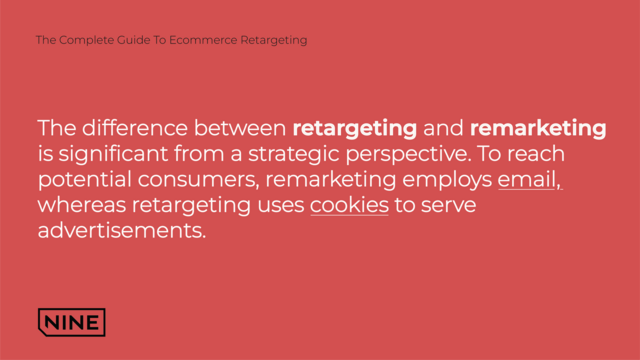
Why Is Retargeting Important for Ecommerce Sites?
An old marketing rule states that consumers must see your marketing efforts seven times (it's more than this now) before making a purchase. Because it allows consumers to see your brand and products again, retargeting is crucial.
Social media and paid search work to bring in top-of-funnel clients, but many will need multiple visits to your site before making a purchase. Retargeting allows us to keep showing relevant information about your product/brand while offering an easy way to return to your site.
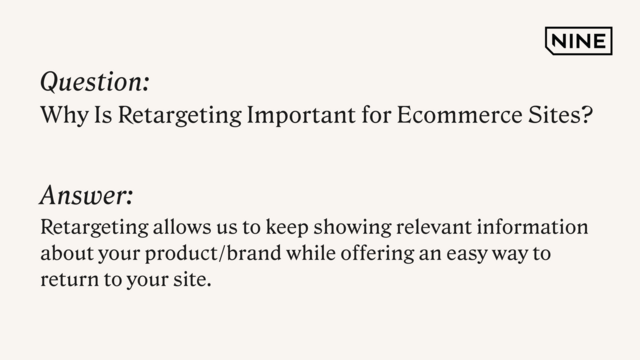
Regulatory Changes to Website Data Collection
Data privacy laws are in effect in many countries. You should know these laws before launching a remarketing campaign that collects personal information from consumers without informing them of why we will use the data.
Because of remarketing platforms, you must disclose your usage of them. For Google AdWords to display your adverts to consumers, the search engine first learns about them to monitor them continuously.
To communicate this to website visitors, you should have a comprehensive legal agreement (the Privacy Policy agreement).
GDP
Before collecting analytical data from or setting advertising cookies in the browsers of EU citizens, online stores must get their unequivocal agreement under the GDPR.
Neither a generic "cookies policy" nor a "cookies banner" will satisfy these needs.
Before we can install advertising cookies on a user's device, we must give the user the option to either click a button to accept their use or opt-out.
The internet serves as a global trading system. Can you say that no one from the EU will ever visit your online store website?
How to Set Up Retargeting Ads
The Google Display Network reaches Over 92% of US visitors across millions of websites, videos, and devices.
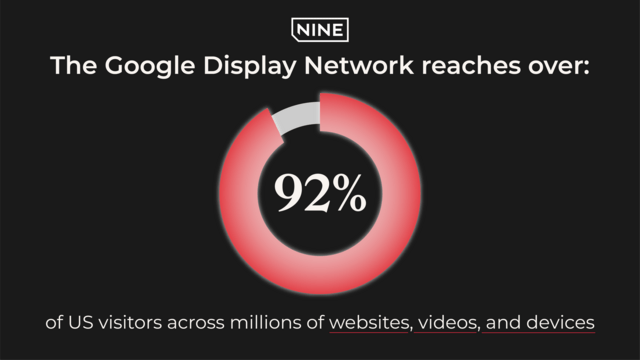
If you want your Google AdWords retargeting campaign to be a success, follow these steps:
Sign in to your account on Google AdWords.
Open the option for "Shared Library."
Choose "Audiences."
Do 'Set-up Remarketing.'
Click on "View AdWords Tag for websites."
Choose and copy the code for the remarketing tag. The tag will work for websites on both phones and computers.
Drop the tag code at the bottom of the web pages you want to use for your campaign.
Save your page and make it public.
Use "Google Tag Assist" to see if your tag works correctly.
Click "Keep Going."
Click "Return to Groups."
After a few days, the tag will start collecting the cookies of all your website visitors and start logging the visitors into the 'All Visitors' list in your account.
Best Practices for Ecommerce Retargeting
Here are the five best Practices for Ecommerce Retargeting.
A/B Testing
A/B testing can help you avoid spending time and money on ads that don't work.
Even the most flexible budgets work when running ads. But if you first test and tweak your campaigns, you can avoid putting out many advertisements that don't work.
Enter A/B testing, a simple method in which you take an ad, change one thing about it, and then compare it to a slightly distinct version. Yes, hello, better ROI!
Let a professional content writing service write your sales copy and buy tools for A/B testing to make the process as smooth as possible.
Retargeting Based on Interests
Has an ad on Google or social media ever stalked you and just had to click "buy"?
It's easy to understand why. You presumably saw an ad for something you previously expressed an interest in.
Whether you wanted to buy an audiobook as a birthday present or try out a new project management tool, the ad gave you the push you needed.
To make retargeting campaigns that work, you need to know what interests each audience segment.
Retargeting Based on Website Activity
Using website activity is another exciting way to retarget leads.
Have you ever looked at a website page and then got ads or emails based on what you saw on that page?
That's the best retargeting based on what people do on a website.
And it works because of two things:
Your retargeting is based on how long someone looks at your product.
You are retargeting based on what people did (leads that may have clicked on your website links, read your blogs, or signed up for your email list).
Since leads have already spent time with your brand for both reasons, you have a great excuse to retarget them.
When retargeting based on what people do on your website, you can get more specific by dividing leads by:
How long they spent on a particular page?
What steps did they (or didn't do) take on a specific page?
What offers they looked at?
The pages they went to and the forms they filled out?
Retargeting Based on Pain-Points
Finding out what makes your audience tick and then retargeting them based on their pain points is a brilliant way to solve problems, which is why you're in business.
Here are some ways to find out what your audience's pain points are:
After a prospect leaves your site, ask them why they left and what could have made them stay longer.
Watch what your leads do and how they buy.
Use a social listening tool to find out what leads are saying about you on social media.
Collect and analyze information about how people act.
Email your leads and ask them about their biggest problems.
Ask for leads through posts on social media and in stories.
Then, use retargeting campaigns with specific messages to let leads know what problems you're trying to solve.
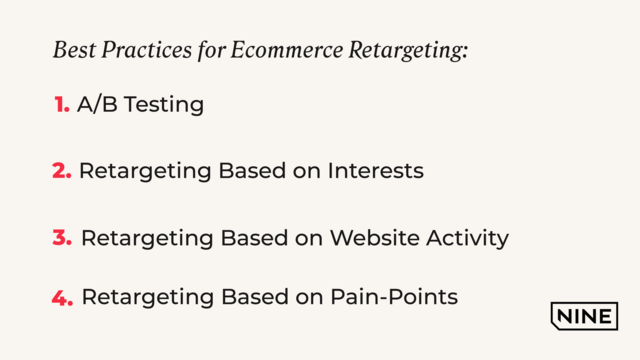
Ecommerce Retargeting Strategies
Nearly everyone who has visited your site or engaged with your brand should be in your pool of retargeting leads and segments. To maximize retargeting effectiveness, narrow the audience to a manageable subset. Here are some examples.
Retargeting Home Page Visitors
Customers who've visited your homepage and explored your site, perhaps clicking through to resources pages, product pages, or the about us section, are ideal candidates for retargeting.
Retargeting Those Who Reach Your Product Page
Customers that visit your product page but don't browse the rest of your website are also suitable candidates for retargeting strategies.
With dynamic retargeting, advertisers may show different visitors different adverts depending on what they look at while browsing your site.
Retargeting Abandoned Carts
If you want users to return to your site, retargeting abandoned checkouts is one of the simplest and most effective strategies you can do.
If a potential customer leaves the shopping cart page without completing their purchase, immediately include them in an ecommerce cart abandonment email series and advertising campaign.
Make customers more inclined to purchase with each ad or email by providing a discount or promo code.
Retargeting Blog Visitors
As mentioned, reduce your advertising spending if people leave your website after seeing only your homepage or one of your informational pages. It would help if you tried re-engaging a visitor still in the "checking you out" stage of the sales funnel. But their value to your business is lower, at least for now.
Use ads to direct visitors who aren't ready to buy over to informational sites with a blog. Or send them to landing pages that provide a soft CTA (like a webinar or ebook download).
Reduce your spending on recent visitors as a percentage of total traffic, and you'll get a greater return on investment from remarketing.
Examples of Successful Ecommerce Retargeting Campaigns
Two examples of successful eCommerce retargeting campaigns are the following.
Beardbrand
We know Beardbrand as one of Shopify's "little guys." What began as a small brand of beard products and skin care for men has grown into a multi-million dollar brand. What did they do?
They executed several marketing strategies to promote their business, but content marketing was the one that worked best.
Beardbrand used an email marketing campaign to tell people about their products and get in touch with them. About 81% of small businesses use email as their primary way to get new customers, and 80% use it to keep the ones they already have.
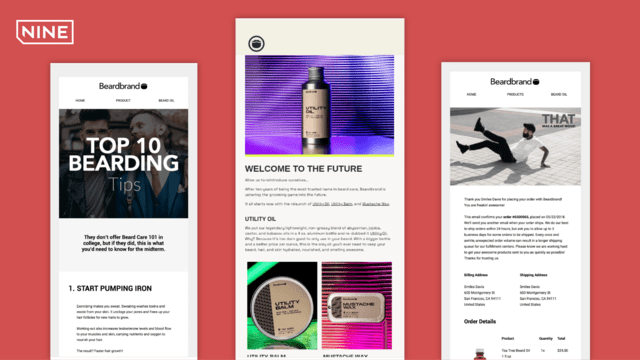
All Bird
All Bird wasn't always as big as it is now. Initially, it was just a tiny online store trying to make a difference in the clothing and shoe industry.
Most of their online brand growth has come from content marketing and word of mouth, which make up 60% of their business.
When they've released a new product, they're known for sending retargeting ads to customers who have shown interest in the new product and their website.

Ecommerce Retargeting Mistakes
When making their targeting strategies, brands often make some common retargeting mistakes that waste time, money, and opportunities. We will discuss the top five retargeting mistakes brands make and how to avoid them for better results.
Retargeting Shoppers Who Have Already Checked Out
When setting up your campaigns, one common retargeting mistake is spending retargeting money on shoppers who have already bought from you. After all, why would someone want to see an ad for something they already bought?
Random Ad Frequency
When planning a retargeting campaign, marketers must be careful about how frequently people see ads. If the ad comes up too often, it might make people less interested in your brand and make you look like a company that follows its customers everywhere. So, too much targeting can hurt more than help your brand's image.
On the flip side, if your retargeting frequency falls short, your work may be for nothing. The shopper may not remember enough about your products and services. Research suggests you should show ads about 15-20 times per month for your retargeting campaigns to give you the best return on investment.
Failing to Segment
Not segmenting your users and showing the same ads to your consumers is not the right way to retarget. It is a much less effective way to do things. So, brands should divide their users into groups based on their browsing, whether new or returning customers, and where they are in the sales funnel.
Not Knowing Where Your Customers Are
Your retargeting campaign will fail if you don't know where your customers spend their time on social media. For example, if you run a teen fashion brand and consumers spend time on Instagram, investing the same time and money on all social media sites wouldn't make sense.
Instead, your retargeting will work better if you set the right priorities and focus on your audience's platforms. Then, you can reach the goals and objectives you set for your retargeting campaign. The more you know about your audience, the better your retargeting strategies will work.
Stale Retargeting Creatives
Your retargeting ads must be creative and send a clear message if you hope to capture attention and not confuse the customer. But if you keep showing the same ad repeatedly, users will tire of it, and your click-through rates will drop significantly.
So, marketers should keep updating their creatives or use dynamic ad strategies to support their campaigns and brands fresh in the minds of potential customers. Retargeting will also help marketers reach their goals by adding a relevant "call-to-action" button to their creatives.
Conclusion
Ecommerce retargeting ads are a vital part of keeping your business going, especially if you want to build a good relationship with your customers and keep them coming back.
The best thing about retargeting ads is that you can talk to your customers even when they aren't on your site or social media. Unlike other ways of communicating that can also, these retargeting ads are a simple but powerful push that doesn't get in the way.
The Nine: Digital Ecommerce Agency
At The Nine, we love helping online stores grow their business. As your digital ecommerce agency, we set up and manage retargeting campaigns for our clients. Schedule a time to learn more about digital retargeting and our other ecommerce services.

